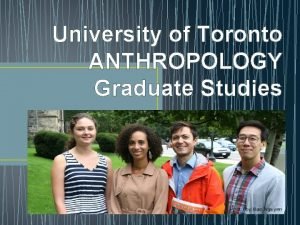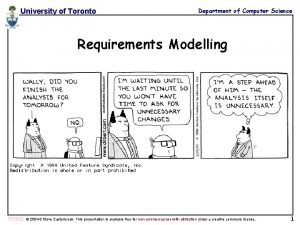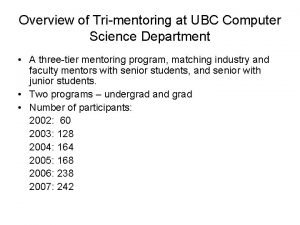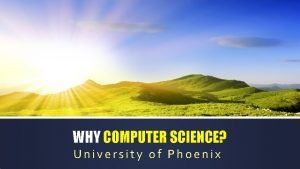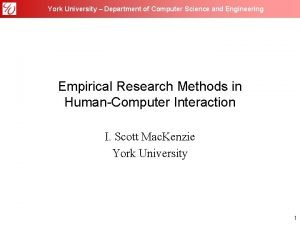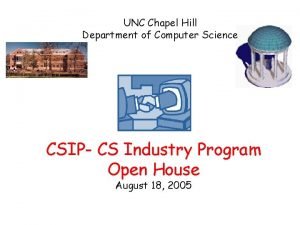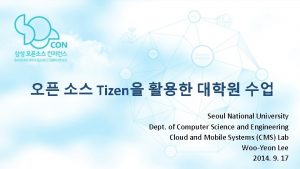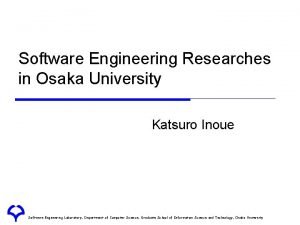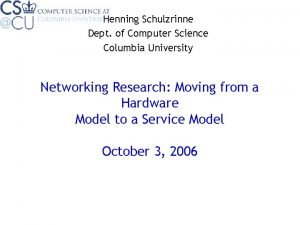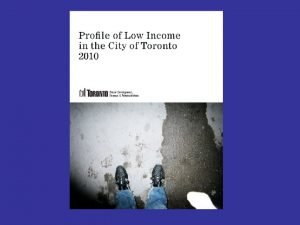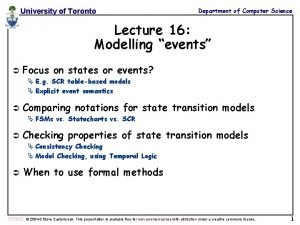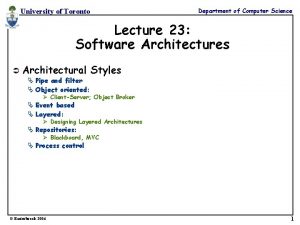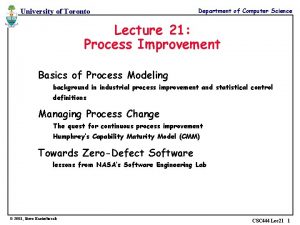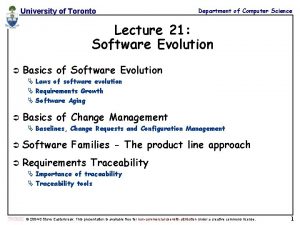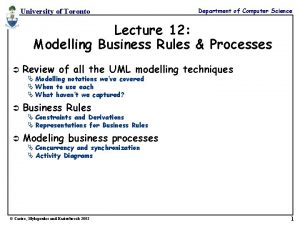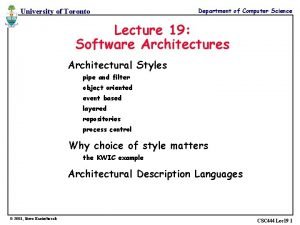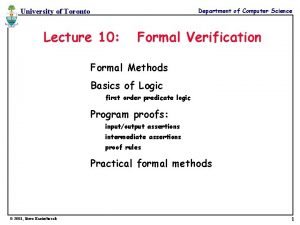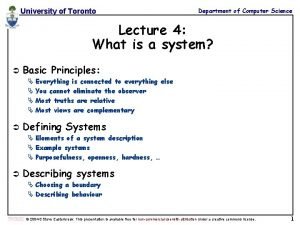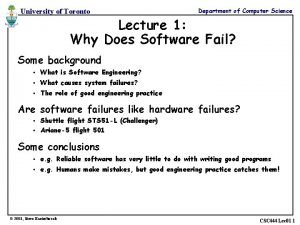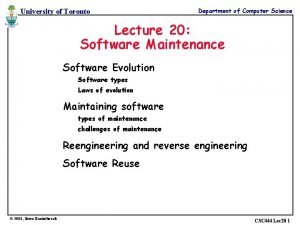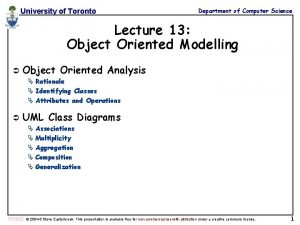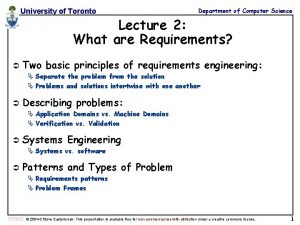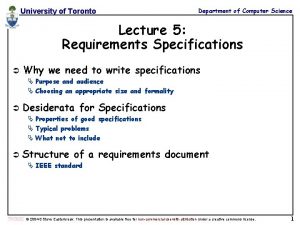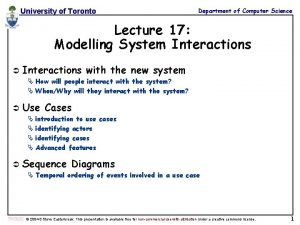University of Toronto Department of Computer Science Requirements




















- Slides: 20

University of Toronto Department of Computer Science Requirements Modelling © 2004 -5 Steve Easterbrook. This presentation is available free for non-commercial use with attribution under a creative commons license. 1

University of Toronto Department of Computer Science Lecture 11: Requirements Modelling Ü A little refresher: Ä What are we modelling? Ä Requirements; Systems Thinking Ü Role of Modelling in RE Ä Why modelling is important Ä Limitations of modelling Ü Brief overview of modelling languages Ü Modelling principles Ä Abstraction Ä Decomposition Ä Projection Ä Modularity © 2004 -5 Steve Easterbrook. This presentation is available free for non-commercial use with attribution under a creative commons license. 2

University of Toronto Department of Computer Science Refresher: Definitions Application Domain D - domain properties R - requirements Ü Machine Domain C - computers P - programs Some distinctions: Ä Domain Properties - things in the application domain that are true whether or not we ever build the proposed system Ä Requirements - things in the application domain that we wish to be made true by delivering the proposed system Ä A specification - a description of the behaviours the program must have in order to meet the requirements Ü Two correctness (verification) criteria: Ä The Program running on a particular Computer satisfies the Specification Ä The Specification, in the context of the given domain properties, satisfies the requirements Ü Two completeness (validation) criteria: Ä We discovered all the important requirements Ä We discovered all the relevant domain properties © 2004 -5 Steve Easterbrook. This presentation is available free for non-commercial use with attribution under a creative commons license. 3

Department of Computer Science University of Toronto Refresher: Systems to model Source: Adapted from Loucopoulos & Karakostas, 1995, p 73 Maintains information about Needs information about Subject System Uses Information system Usage System builds contracts Development System © 2004 -5 Steve Easterbrook. This presentation is available free for non-commercial use with attribution under a creative commons license. 4

University of Toronto Department of Computer Science Refresher: Systems Thinking © 2004 -5 Steve Easterbrook. This presentation is available free for non-commercial use with attribution under a creative commons license. 5

Department of Computer Science University of Toronto Modelling… Ü Modelling can guide elicitation: Ä It can help you figure out what questions to ask Ä It can help to surface hidden requirements Ø i. e. does it help you ask the right questions? Ü Modelling can provide a measure of progress: Ä Completeness of the models -> completeness of the elicitation (? ) Ø i. e. if we’ve filled in all the pieces of the models, are we done? Ü Modelling can help to uncover problems Ä Inconsistency in the models can reveal interesting things… Ø e. g. conflicting or infeasible requirements Ø e. g. confusion over terminology, scope, etc Ø e. g. disagreements between stakeholders Ü Modelling can help us check our understanding Ä Reason over the model to understand its consequences Ø Does it have the properties we expect? Ä Animate the model to help us visualize/validate the requirements © 2004 -5 Steve Easterbrook. This presentation is available free for non-commercial use with attribution under a creative commons license. 6

Department of Computer Science University of Toronto RE involves a lot of modelling Source: Adapted from Jackson, 1995, p 120 -122 Ü A model is more than just a description Ä it has its own phenomena, and its own relationships among those phenomena. Ø The model is only useful if the model’s phenomena correspond in a systematic way to the phenomena of the domain being modelled. Ä Example: ISBN title Book (1, n) The application domain author Designations for the application domain B = Book P = Person R = Wrote Common Properties (0, n) Book: entity Person: entity author: relation name The modelling Person domain Designations for the model’s domain For every B, at least one P exists such that R(P, B) © 2004 -5 Steve Easterbrook. This presentation is available free for non-commercial use with attribution under a creative commons license. 7

Department of Computer Science University of Toronto “It’s only a model” Source: Adapted from Jackson, 1995, p 124 -5 Ü There will always be: Ä phenomena in the model that are not present in the application domain Ä phenomena in the application domain that are not in the model ISBN title name DOB Book (1, n) author Phenomena not captured in the model …ghost writers… …pseudonyms… …anonymity… Ü (0, n) Person Phenomena not true in the world Common Phenomena …every book has at least one author… …every book has a unique ISBN… …no two people born on same date with same name… A model is never perfect Ä “If the map and the terrain disagree, believe the terrain” Ä Perfecting the model is not always a good use of your time. . . © 2004 -5 Steve Easterbrook. This presentation is available free for non-commercial use with attribution under a creative commons license. 8

Department of Computer Science University of Toronto Choice of modelling notation Source: Adapted from Loucopoulos & Karakostas, 1995, p 72 -73 Ü natural language Ä extremely expressive and flexible Ø useful for elicitation, and to annotate models for readability Ä poor at capturing key relationships Ü semi-formal notation UML fits in here Ä captures structure and some semantics Ä can perform (some) reasoning, consistency checking, animation, etc. Ø E. g. diagrams, tables, structured English, etc. Ä mostly visual - for rapid communication with a variety of stakeholders Ü formal notation Ä precise semantics, extensive reasoning possible Ø Underlying mathematical model (e. g. set theory, FSMs, etc) Ä very detailed models (may be more detailed than we need) Ø RE formalisms are for conceptual modelling, hence differ from most computer science formalisms © 2004 -5 Steve Easterbrook. This presentation is available free for non-commercial use with attribution under a creative commons license. 9

Department of Computer Science University of Toronto Desiderata for Modelling Notations Source: Adapted from Loucopoulos & Karakostas, 1995, p 77 Ü Implementation Independence Ü Ä does not model data representation, internal organization, etc. Ü Abstraction Ä ability to analyze for ambiguity, incompleteness, inconsistency Ü Ä extracts essential aspects Formality Ä unambiguous syntax Ä rich semantic theory Ü Constructability Ä can construct pieces of the model to handle complexity and size Ä construction should facilitate communication Traceability Ä ability to cross-reference elements Ä ability to link to design, implementation, etc. Øe. g. things not subject to frequent change Ü Ease of analysis Ü Executability Ä can animate the model, to compare it to reality Ü Minimality Ä No redundancy of concepts in the modelling scheme Øi. e. no extraneous choices of how to represent something © 2004 -5 Steve Easterbrook. This presentation is available free for non-commercial use with attribution under a creative commons license. 10

Department of Computer Science University of Toronto Survey of Modelling Techniques Ü Modelling Enterprises Ä Goals & objectives Ä Organizational structure Ä Tasks & dependencies Ä Agents, roles, intentionality Ü Organization modelling: i*, SSM, ISAC Goal modelling: KAOS, CREWS Modelling Information & Behaviour Ä Information Structure Ä Behavioral views Ø Scenarios and Use Cases Ø State machine models Ø Information flow Information modelling: E-R, Class Diagrams Structured Analysis: SADT, SSADM, JSD Object Oriented Analysis: OOA, OOSE, OMT, UML Formal Methods: SCR, RSML, Z, Larch, VDM Ä Timing/Sequencing requirements Quality tradeoffs: QFD, win-win, AHP, Ü Modelling System Qualities (NFRs) Specific NFRs: Timed Petri nets (performance) Ä All the ‘ilities’: Task models (usability) Ø Usability, reliability, evolvability, safety, Probabilistic MTTF (reliability) security, performance, interoperability, … © 2004 -5 Steve Easterbrook. This presentation is available free for non-commercial use with attribution under a creative commons license. 11

University of Toronto Department of Computer Science the Unified Modelling Language (UML) Ü Third generation OO method Ä Booch, Rumbaugh & Jacobson are principal authors Ø Still evolving Ø Attempt to standardize the proliferation of OO variants Ä Is purely a notation Ø No modelling method associated with it! Ø Was intended as a design notation (some features unsuitable for RE) Ä Has become an industry standard Ø But is primarily owned by IBM/Rational (who sell lots of UML tools and services) Ü Has a standardized meta-model Ä Use case diagrams Ä Class diagrams Ä Message sequence charts Ä Activity diagrams Ä State Diagrams Ä Module Diagrams Ä Platform diagrams © 2004 -5 Steve Easterbrook. This presentation is available free for non-commercial use with attribution under a creative commons license. 12

Department of Computer Science University of Toronto Meta-Modelling Ü Can compare modelling schema using meta-models: Ä What phenomena does each scheme capture? Ä What guidance is there for how to elaborate the models? Ä What analysis can be performed on the models? Ü Example meta-model: refine Goals own implement refine Agents assigned to Tasks © 2004 -5 Steve Easterbrook. This presentation is available free for non-commercial use with attribution under a creative commons license. 13

University of Toronto Department of Computer Science Modelling principles Ü Facilitate Modification and Reuse Ä Experienced analysts reuse their past experience Ø they reuse components (of the models they have built in the past) Ø they reuse structure (of the models they have built in the past) Ä Smart analysts plan for the future Ø they create components in their models that might be reusable Ø they structure their models to make them easy to modify Ü Helpful ideas: Ä Abstraction Ø strip away detail to concentrate on the important things Ä Decomposition (Partitioning) Ø Partition a problem into independent pieces, to study separately Ä Viewpoints (Projection) Ø Separate different concerns (views) and describe them separately Ä Modularization Ø Choose structures that are stable over time, to localize change Ä Patterns Ø Structure of a model that is known to occur in many different applications © 2004 -5 Steve Easterbrook. This presentation is available free for non-commercial use with attribution under a creative commons license. 14

University of Toronto Department of Computer Science Modelling Principle 1: Partitioning Ü Partitioning Ä captures aggregation/part-of relationship Ü Example: Ä goal is to develop a spacecraft Ä partition the problem into parts: Ø Ø Ø guidance and navigation; data handling; command control; environmental control; instrumentation; etc Ä Note: this is not a design, it is a problem decomposition Ø actual design might have any number of components, with no relation to these sub -problems Ä However, the choice of problem decomposition will probably be reflected in the design © 2004 -5 Steve Easterbrook. This presentation is available free for non-commercial use with attribution under a creative commons license. 15

Department of Computer Science University of Toronto Modelling Principle 2: Abstraction Source: Adapted from Davis, 1990, p 48 and Loucopoulos & Karakostas, 1995, p 78 Ü Abstraction Ä A way of finding similarities between concepts by ignoring some details Ä Focuses on the general/specific relationship between phenomena Ø Classification groups entities with a similar role as members of a single class Ø Generalization expresses similarities between different classes in an ‘is_a’ association Ü Example: Ä requirement is to handle faults on the spacecraft Ä might group different faults into fault classes based on location: based on symptoms: Ä instrumentation fault, Ä no response from device; Ä communication fault, Ä incorrect response; Ä processor fault, Ä self-test failure; Ä etc. . . © 2004 -5 Steve Easterbrook. This presentation is available free for non-commercial use with attribution under a creative commons license. 16

Department of Computer Science University of Toronto Modelling Principle 3: Projection Source: Adapted from Davis, 1990, p 48 -51 Ü Projection: Ä separates aspects of the model into multiple viewpoints Ø similar to projections used by architects for buildings Ü Example: Ä Need to model the requirements for a spacecraft Ä Model separately: Ø Ø Ø Ü safety commandability fault tolerance timing and sequencing Etc… Note: Ä Projection and Partitioning are similar: Ø Partitioning defines a ‘part of’ relationship Ø Projection defines a ‘view of’ relationship Ä Partitioning assumes a the parts are relatively independent © 2004 -5 Steve Easterbrook. This presentation is available free for non-commercial use with attribution under a creative commons license. 17

Department of Computer Science University of Toronto A brief UML example Source: Adapted from Davis, 1990, p 67 -68 Generalization (an abstraction hierarchy) Aggregation (a partitioning hierarchy) : patient Name Date of Birth physician history 0. . 1 : in-patient Room Bed Treatments food prefs : out-patient Last visit next visit prescriptions 1 : heart Natural/artif. Orig/implant normal bpm 1. . 2 0. . 2 : kidney Natural/artif. Orig/implant number : eyes Natural/artif. Vision colour © 2004 -5 Steve Easterbrook. This presentation is available free for non-commercial use with attribution under a creative commons license. 18

University of Toronto Department of Computer Science What is this a model of? © 2004 -5 Steve Easterbrook. This presentation is available free for non-commercial use with attribution under a creative commons license. 19

Department of Computer Science University of Toronto Summary Ü Modelling plays a central role in RE Ä Allows us to study a problem systematically Ä Allows us to test our understanding Ü Many choices for modelling notation Ä In this course, we’ll use (and adapt) various UML notations Ü All models are inaccurate (to some extent) Ä Use successive approximation Ä …but know when to stop perfecting the model Ä Every model is created for a purpose Ä The purpose is not usually expressed in the model Ä …So every model needs an explanation © 2004 -5 Steve Easterbrook. This presentation is available free for non-commercial use with attribution under a creative commons license. 20
 Columbia university department of computer science
Columbia university department of computer science Department of anthropology
Department of anthropology Uoft computer science requirements
Uoft computer science requirements Bsc computer science ucl
Bsc computer science ucl Northwestern electrical engineering
Northwestern electrical engineering Computer science department rutgers
Computer science department rutgers Computer science department stanford
Computer science department stanford Mch fsu
Mch fsu Ubc computer science department
Ubc computer science department Department of computer science christ
Department of computer science christ Whats your favorite subject
Whats your favorite subject University of phoenix computer science
University of phoenix computer science University of bridgeport engineering
University of bridgeport engineering Bridgeport engineering department
Bridgeport engineering department Yonsei university computer science
Yonsei university computer science York university computer science
York university computer science Unc chapel hill computer science
Unc chapel hill computer science Seoul national university computer science
Seoul national university computer science Osaka university computer science
Osaka university computer science Computer science columbia university
Computer science columbia university 7800 york road
7800 york road

